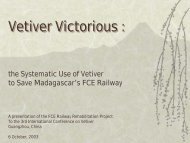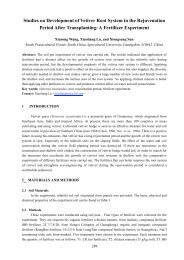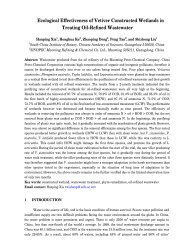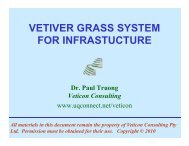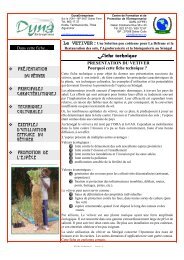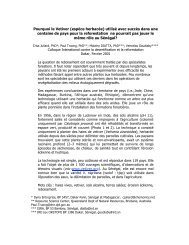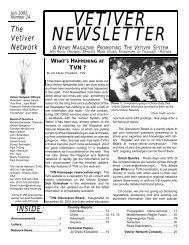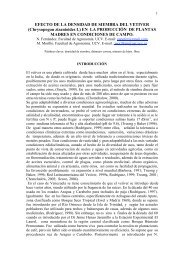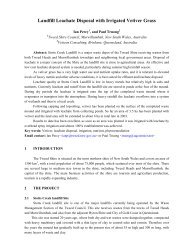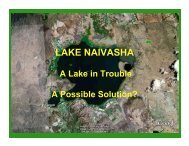technical fact sheet - The Vetiver Network International
technical fact sheet - The Vetiver Network International
technical fact sheet - The Vetiver Network International
Create successful ePaper yourself
Turn your PDF publications into a flip-book with our unique Google optimized e-Paper software.
S. China landfill before treatment S. China landfill after vetiver treatment<br />
<strong>The</strong> <strong>Vetiver</strong> System is comprised<br />
of a set of applications that<br />
addresses several important soil<br />
and water conservation issues.<br />
This document discusses those<br />
applications that appear to be<br />
most relevant to the problems<br />
faced by the US littoral states of<br />
the Gulf of Mexico and guides the<br />
reader to supporting documents. Bridge infrastructure solidly protected<br />
Comprehensive water pollution control: <strong>Vetiver</strong> hedges planted as “buffer<br />
strips” around crops, such as cotton or sugar cane, trap soil particles and<br />
sediment-borne agrochemicals, preventing this nonpoint source of pollution<br />
from migrating offsite. http://www.vetiver.com/PRVN_IVC2_19.PDF<br />
Constructed wetlands of vetiver grass are biological filters that “polish” point<br />
source pollution, such as pre-treated wastewater effluents. See<br />
http://www.vetiver.com/ICV3-Proceedings/AUS_sewage.pdf Even landfill<br />
leachate, normally toxic to most plants, can be intercepted and treated by<br />
vetiver hedges. http://www.vetiver.com/ICV3-Proceedings/AUS_Landfill.pdf<br />
This remarkable plant can help reduce water pollution across the entire<br />
spectrum of sources.<br />
Protection of embankments: Hedges of vetiver grass planted on the<br />
contour lines of sloped land protect the banks of canals and rivers and<br />
coastal levees against soil erosion from wave action and lateral scouring<br />
from a river current. How does vetiver do all this? <strong>Vetiver</strong>’s massive root<br />
system can not be dislodged by moving water, and it anchors the upper<br />
three to four meters of the soil profile. <strong>Vetiver</strong> roots have an average tensile<br />
strength of 75 MPa (about 1/6 that of mild steel), which increases the<br />
average shear strength of the surrounding soil by 30% to 40%. <strong>The</strong> effect is<br />
to stabilize the levee, dam or other soil structure against scouring by water<br />
or wind . Refer to: http://www.vetiver.com/VNN_truong_jan2005.pdf<br />
Protection of civil works: When vetiver grass is planted at the interface<br />
between soil, concrete structures (culverts, drains, bridge supports) and<br />
moving water it prevents undermining and loss of structural integrity. After<br />
years of testing, the ministries of transportation of five southern provinces of<br />
China have standardized on the <strong>Vetiver</strong> System as a more effective and<br />
lower cost alternative to conventional civil works, such as bench terracing,<br />
gabions and rip-rap. <strong>The</strong> <strong>Vetiver</strong> System stabilizes the third steepest railroad<br />
in the world In Madagascar, so that it now survives regular cyclonic storms<br />
without significant interruption of service to the farmers who depend on it.<br />
Refer to: http://www.vetiver.com/ICV3-Proceedings/MAD_rail_stab.pdf2.pdf<br />
Stabilization of coastal dunes, barrier islands and wetlands: <strong>Vetiver</strong><br />
grass is at home in a marsh environment and in littoral areas, including<br />
either dry or saturated soils. It can survive prolonged inundation in fresh or<br />
brackish waters. Eroding dunes, barrier islands and brackish marshes can<br />
be stabilized by systematic deployment of vetiver hedges. <strong>Vetiver</strong> serves as<br />
pioneer plants to assist native to plants establish themselves, giving way to<br />
those plants over time. Refer to dune stabilization documentation at:<br />
http://www.vetiver.com/ICV3-Proceedings/VNN_sanddune.pdf<br />
<strong>Vetiver</strong> grass has special characteristics<br />
that lend themselves to protection of<br />
infrastructure and control of water-related<br />
pollution:<br />
o<br />
o<br />
o<br />
o<br />
o<br />
<strong>The</strong> sterile “Sunshine” cultivar of vetiver<br />
grass embodies a wide spectrum of<br />
properties that are rarely combined in a<br />
single species. <strong>The</strong> result is uncommon<br />
versatility and hardiness;<br />
<strong>Vetiver</strong> grass has stiff, erect stems that<br />
form a dense hedge that can stand up to<br />
high velocity water flows. That porous<br />
barrier prevents scouring of the soil on<br />
sloped land; <strong>The</strong> stems and leaves form<br />
a “filter strip” that traps soil particles and<br />
agrochemicals such as pesticides that<br />
are adsorbed onto the particles;<br />
<strong>Vetiver</strong> hedges need little maintenance<br />
over an open-ended working life;<br />
Fine, dense, penetrating roots anchor<br />
the soil profile up to four meters deep,<br />
preventing wind and water erosion and<br />
forming an underground barrier to water<br />
flow down the slope;<br />
Constructed wetlands of vetiver grass<br />
are biological sinks that assimilate<br />
residual N and P and other pollutants<br />
from pre-treated wastewater effluents;<br />
o <strong>Vetiver</strong> grass tolerates saline soils (50%<br />
yield reduction at 20 dS/m; lethal at 45<br />
dS/m); vetiver hedges are effective in<br />
stabilizing coastal dunes and levees,<br />
beaches and barrier islands; and<br />
o<br />
<strong>Vetiver</strong> grass is a perennial, infertile,<br />
non-invasive plant that is incapable of<br />
migrating from its planting site; it is<br />
cleared for use in the United States,<br />
including Hawaii and Puerto Rico by<br />
USDA and widely available through<br />
commercial nurseries;<br />
Profile of a vetiver contour hedge<br />
Image above: To the left of this three year old<br />
hedge in Malaysia, more than 40 cm of soil<br />
has been trapped behind the hedge. <strong>The</strong><br />
original soil level is indicated by the black<br />
subsoil band. <strong>The</strong> vertical white marker<br />
indicates the original site on the contour line<br />
of the slope where vetiver was transplanted.




